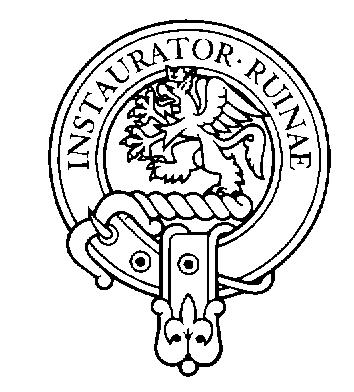Forsyth Heraldry
The arms of forsyth of that ilk, chief of clan forsyth
Heraldry was, and still is, a complex system governed by strict rules. In Scotland, the Lord Lyon King of Arms is the authority responsible for granting and maintaining these heraldic traditions.
Forsyth Heraldry Explained
Armorial bearings, also known as coats of arms and crests, are a form of property that belong to and identifies members of one particular family. These heraldic symbols do not apply to all individuals with the Forsyth surname, but rather to the male-line descendants of the original grant recipient. In Scotland, these grants are made through the Court of the Lord Lyon.
A person who has been granted or inherited a coat of arms or crest through the Law of Arms in Scotland may wear their own crest as a badge, either on its wreath, crest coronet, or chapeau. More commonly, the crest is displayed with a plain circlet inscribed with a motto. Non-armigerous clan members may wear the chief’s crest encircled by a strap and buckle inscribed with the chief’s motto.
Elements of Forsyth Armorial Bearings
The Forsyth Chief’s coat of arms is made up of various elements, each with its own meaning:
The Motto: A personal statement that reflects the values of the family.
The Mantling: A decorative cloth that represents protection in battle.
The Crest: Positioned above the shield, representing an individual’s status.
The Supporters: Figures that stand on either side of the shield.
The Shield and Arms: The central element that reflects the family’s history and achievements.
In addition, the posture of the figures in the crest holds significance. For example, a creature depicted as "segreant" (like a griffin or dragon) has both forelegs raised, with wings elevated and set back. This term is reserved for winged quadrupeds.
James Forsyth’s Coat of Arms
In 1672, James Forsyth of Tailzertoune, minister of Stirling, a descendant of the Forsyth of Dykes, registered his Coat of Arms and Motto, with the Court of the Lord Lyon “Argent, a chevron engrailed Gules between three griffins sergeant Azure armed and membered Sable, Crowned Or” “Instaurator ruinae" (Scotlandspeople,Coat of Arms, Vol 1 page 303Z)
Forsyth Shield
Here's what it means broken down:
Argent: This refers to the color silver or white, representing peace and sincerity. It is the background (or "field") of the shield.
A chevron engrailed Gules:
A chevron is a V-shaped symbol, like an upside-down "V", which often represents protection or service in battle.
Engrailed means the edges of the chevron are not straight but have small, curved indentations, creating a scalloped look.
Gules means the chevron is red, symbolizing strength, warrior-like qualities, and magnanimity.
Between three griffins sergeant Azure:
The shield is also decorated with three griffins. A griffin is a mythical creature with the body of a lion and the head and wings of an eagle, symbolizing courage and boldness.
Sergeant indicates the posture of the griffins, which means they are depicted in a rearing position with both forelegs raised, ready for combat.
Azure means the griffins are colored blue, symbolizing loyalty and truth.
Armed and membered Sable:
Armed refers to the claws of the griffins, which are Sable (black), symbolizing constancy and sometimes grief or sorrow.
Membered means the other extremities of the griffins, such as legs and beaks, are also black.
Crowned Or: The griffins are wearing crowns colored Or, which means gold. Gold represents generosity and elevation of the mind.
In summary:
The coat of arms features a silver shield with a red V-shaped chevron with scalloped edges in the center. Three blue griffins, shown in a rearing position with black claws and beaks, are spaced around the chevron. These griffins are wearing gold crowns.



